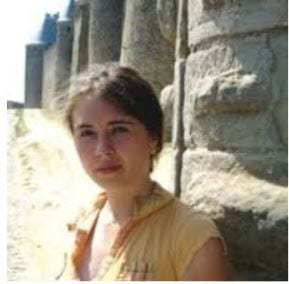The Delaware INBRE Pilot Awards offer needed assistance to early-career investigators on the path to research independence.
Pilot Projects 2019-2021
Anjana Bhat, PhD
Associate Professor, Physical Therapy
University of Delaware
Project title: A multisystem, multimodal intervention for children with ASD
Thematic area: Neuroscience
Summary: We propose to examine effects of an 8-week novel synchronous, multisystem, multimodal play intervention to facilitate social communication and motor skills of children with Autism Spectrum Disorder (ASD). Our preliminary studies showed that practicing musical synchrony as a group led to highest levels of social attention and increase in amount of social verbalization as well as an increase in imitation accuracy and percent of interpersonal synchrony following 8 weeks of intervention compared to a sedentary play group. While we are encouraged by the positive behavioral findings, we still do not know the neural mechanisms that facilitate social communication skills when children engage in socially embedded, synchronous whole body movements.
Elise Corbin, PhD
Assistant Professor , Biomedical Engineering
University of Delaware
Project title: Mechanical Phenotypes of Sepsis-Induced Cardiomyopathy
Theme area: Neuroscience
Summary: The long-term goal of this research is to develop an in vitro model of sepsis-induced cardiomyopathy to
elucidate fundamental mechanisms of pathology and enable development of effective treatments. Sepsis is
a systemic immune response to infection that can have serious consequences including organ dysfunction and mortality. Cardiovascular dysfunction is common in sepsis though the mechanics of this cardiomyopathy is unknown. As such, no existing therapy directly targets intrinsic cardiac injury in sepsis despite extensive evidence of its prevalence, and treatment is currently limited to antimicrobial agents and
circulatory support (i.e. vasopressors) applied broadly to patients with a sepsis syndrome.
Christine Charvet, PhD
Assistant Professor, Psychology
Delaware State University
Project title: Translating ages in humans and model organisms across the lifespan
Thematic area: Neuroscience
Summary: The goal of this project is to identify corresponding ages across postnatal ages in humans and model
organisms. This work is needed because scientists often use model organisms such as mice to understand basic biological processes and disorders in humans, but there is currently no resource that enables researchers to find corresponding ages across the lifespan of model organisms and humans.
Catherine Fromen, PhD

Assistant professor, Chemical & Biomolecular Engineering
University of Delaware
Project title: Aged to perfection: Enhancing survival of antigen presenting cells for cancer therapies
Theme area: Cancer
Summary: Macrophages and dendritic cells (DCs) are important effector cells of the innate immune system
responsible for clearing foreign objects and bridging the innate and adaptive immunity. During lung cancer,
both cell types undergo considerable dysfunction and contribute to a protumor environment. Restoration of proper innate immune cell function may enable these cells to combat the cancer and reduce tumor burden, thus both macrophages and DCs represent significant targets for lung cancer therapies. The overall objective of this work is to 1) investigate the mechanism of NP-induced phagocyte longevity and 2) develop a substantial framework for controlling cell viability for lung cancer therapies.
Jennifer Goldstein, MD
Assistant Program Director, Internal Medicine Residency Program, Director of Resident Research
Christiana Care
Project title: The impact of social determinants of health on medical decision making in diabetes care
Thematic area: Cardiovascular
Summary: Completion of this research program will be the first step in examining whether and how physicians integrate data related to SDoH into their clinical management plans. Our findings will advance precision medicine by clarifying current practice related to collection of SDoH data and whether it triggers clinical action or inertia among physicians. This will be critical to understanding whether SDoH screening could lead to meaningful clinical changes that could reduce health care disparities.
Jing Jin, MD
Ophthalmologist, Division of Pediatric Ophthalmology, Department of Surgery
Nemours, A.I. duPont Hospital for Children
Project title: Non-invasive monitoring of sickle cell disease progression via OCT and ERG
Thematic area: Cancer
Summary: The research proposed in this application will utilize a combination of standard and novel noninvasive diagnostic modalities to examine retinal structure and function in children with SCD. Using these techniques will improve our ability to accurately diagnose and monitor SCR in children and provide a better understanding of the pathophysiology of the disease. Through this study, we will refine our ability to predict progression, assess therapeutic efficacy, develop more effective monitoring guidelines and initiate early interventions. Correlating retinal findings with clinical data may provide insight into other vascular complications of SCD, such as cerebrovascular disease. The long-term goal of this study is to enhance early detection of SCR and develop treatment strategies to slow the progression of SCR toward proliferative retinopathy and blindness, lowering the societal burden of SCR and improving the quality of life for these patients.
Karl Milletti-Gonzalez, PhD
Associate Professor, Biological Sciences
Delaware State University
Project title: Regulation of oxidative stress by CD44 in triple negative breast cancercells from African American women
Thematic area: Cancer
Summary: The objective of the proposed study is to investigate a potential underlying molecular mechanism by which CD44 regulates the oxidative stress response via the CD44-ICD in TNBC cells from AA women. Our central hypothesis is that the involvement of CD44 in the oxidative stress response includes 1) protein-DNA interactions between the CD44-ICD and its response element (CIRE) on promoters of NFE2L2 and KEAP1 and 2) protein-protein interactions between Runx2 and/or p53 and the CD44-ICD to regulate the expression of NFE2L2 and the Nrf2 function. This regulatory mechanism is proposed to show differences in TNBC cells from AA women compared to TNBC cells from EA women.
Jeffrey Mugridge, PhD
Assistant Professor, Chemistry & Biochemistry
University of Delaware
Project title: Selectivity and function of RNA demethylase FTO: from structure to glioblastoma
Thematic area: Cancer
Summary:This project will use structural studies to understand how FTO recognizes m6Am modifications on the mRNA 5′ cap and biochemically dissect FTO m6A versus m6Am selectivity in vitro and in glioblastoma models. Metastable intermediates that arise during FTO-mediated demethylation will also be leveraged to develop aptamer-based probes that can directly bind and capture RNA at the site of demethylation. These tools can later be used in sequencing applications to map FTO-mediated RNA demethylation in cellular mRNA.
Rahul Nikam, MD
Radiologist/Assistant Professor of Radiology & Pediatrics
Nemours / A.I. duPont Hospital for Children
Project title: Magnetic Resonance Elastography in Characterization of Pediatric Gliomas
Thematic area: Neuroscience
Summary: In this project we intend to bridge the gap between the various grades and genetic subtypes of pediatric glimoa, and MRE derived viscoelastic mechanical properties. There are no studies done in pediatric brain tumor population evaluating the relationship of tumor stiffness with tumor grade, genetic alterations and proliferation index.
Pilot Projects 2016-2018
Team #1

Sonali Barwe, PhD
Research Scientist
Nemours/Alfred I. duPont Hospital for Children
Project title: The role of epigenetic therapy in reversing adhesion mediated drug resistance in leukemia.
Thematic area: Cancer
Summary: Acute lymphoblastic leukemia ALL is the most common pediatric leukemia. Although most patients are cured, about 20 percent relapse because of drug-resistant leukemic cells retained within the bone marrow. This study aims to establish the use of epigenetic therapy for treatment of all relapsed ALL. The data also will aid in detection and prediction of clinical response to epigenetic therapy.
 Anilkumar Gopalakrishnapillai, PhD
Anilkumar Gopalakrishnapillai, PhD
Assistant Research Scientist II
Nemours/Alfred I. duPont Hospital for Children
Nemours Biomedical Research
Project title: Deciphering the mechanism of Down syndrome leukemia (DS-AML) biogenesis using isogenic iPSC lines and CRISPR/Cas9 technology
Thematic area: Cancer
Summary: The goal of this study is to identify key targets involved in the development of acute myeloid leukemia in children with Down syndrome (DS-AML). Currently, no targeted therapeutics are available for this disease to avoid toxic side-effects from chemotherapy. When completed, this study will aid in developing targeted therapy against DS-AML.
Team #2
Shirin Modarai, PhD
Junior Research Scientist
Christiana Care Health System
Center for Translational Cancer Research/Helen F. Graham Cancer Center and Research Institute
Thematic area: Cancer
Summary: Colorectal cancer (CRC) is the third-leading cancer for men and women in the United States. Tumor formation and growth is thought to occur due to stem cell overpopulation. Current anti-cancer therapies can sometimes shrink tumors by killing the rapidly proliferating cells, but since cancer stem cells (CSCs) are not typically actively dividing, they are not targeted during the development and use of chemotherapeutic drugs. This may explain why there is such a high rate of disease recurrence for most cancers. Since CSCs are responsible for driving tumor growth it is critical to find markers that can identify these cells and eliminate them from the tumor. Aldehyde dehydrogenase (ALDH) is a reliable biological marker. The proposed project aims to identify a specific sub-population of ALDH+CSCs that leads to stem cell overpopulation and ultimately will lead to more innovative anticancer targeted therapies.
 Cheng-Yu Lai, PhD
Cheng-Yu Lai, PhD
Associate Professor, Chemistry
Delaware State University
Project: Targeted Nanoparticles to Deliver APC Tumor Suppressor Protein for Treatment of Colon Cancer
Theme area: Cancer
Summary: Successful demonstration of intracellular APC protein delivery that leads to restoring homeostasis in colorectal cancer will create the foundation for a novel targeted protein therapy of colon cancer.
Individual Pilot Projects

Lisa Jaremka, PhD
Assistant professor, Psychological and Brain Sciences
University of Delaware
Project: Appetite Regulation and Food Intake: Novel Mechanisms Linking Marital Distress to Cardiovascular Risk
Theme area: Cardiovascular
Summary: Cardiovascular disease (CVD) is the leading cause of death in the United States and worldwide. Medical costs associated with treating CVD-related problems are estimated at $315.4 billion per year in the US alone. Distressed marriages are a reliable risk factor for the development and progression of cardiovascular problems.
This project will provide novel information about appetite dysregulation and increased food intake as mechanisms that underlie the link between marital distress and cardiovascular risk. Ultimately, these data could provide important targets for focused interventions that would help prevent cardiovascular problems from developing.

Susanne Morton, PhD
Associate professor, Physical Therapy
University of Delaware
Project: Noninvasive Brain Stimulation to Improve Motor Learning Post-Stroke
Thematic area: Neuroscience
Summary: Stroke is a leading cause of serious long-term disability for which the only treatment is physical rehabilitation. During rehabilitation, stroke patients must learn or relearn movements that have been lost due to damage to the motor regions of the brain. Unfortunately, motor learning after stroke is often poor. In this project, we will test whether non-invasive brain stimulation in the form of transcranial direct current stimulation (tDCS) improves motor learning after stroke and we will determine if tDCS works on motor learning by temporarily increasing brain excitability. Findings will lead to important advancements in motor learning-based interventions to improve motor recovery for people with stroke.

Jessica Tanis, PhD
Assistant professor, Biological Sciences
University of Delaware
Project: Role of the CLHM-1 ion channel in C. elegans neurons
Thematic area: Neuroscience
Summary: More than 5 million Americans live with Alzheimer’s disease, a neurodegenerative brain disorder that causes dementia in elderly individuals. It is important to understand the factors that contribute to AD pathogenesis.
The P86L polymorphism in Calcium homeostasis modulator 1 (CALHM1) influences Alzheimer’s disease age of onset. CALHM1 knockout mice exhibit a significant increase in the steady state levels of amyloid beta, a causative factor in Alzheimer’s disease. However, the physiological function of CALHM1 in the brain remains unclear.
CALHM1 and its C. elegans homolog CLHM-1 have been shown to belong to a new family of ion channels that exhibit shared biophysical properties when expressed in heterologous systems and functional conservation when expressed in C. elegans. The goal of our research is to use the C. elegans model system to determine how the activation and regulation of CALHM channels alters neuronal signaling in vivo.
 Erik Thostenson
Erik Thostenson
Associate Professor, Mechanical Engineering
University of Delaware
Project: Novel Flexible Sensors in Functional Fabrics for Performance Monitoring
Thematic area: Neuroscience
Summary: People with movement difficulties use significantly different joint postures to achieve activities of daily living, which may be larger or smaller than their neurologically healthy counterparts. By monitoring everyday movement of a particular limb outside a laboratory setting, the opportunity exists to provide feedback or intervention to enhance function and improve quality of life.This pilot project aims to create and validate a new class of novel flexible sensors for integration in functional garments capable of measuring joint motions and forces during daily living.
Integrated Team Research Project
The integrated research team involves multiple pilot investigators working under a senior investigator to develop a multidisciplinary team across different institutions.
Project: Relationships between hgh-frequency, low-magnitude vibration (HLV) treatment and improvement in brain and muscle structure and functional outcomes measures in children with cerebral palsy
Thematic area: Neuroscience
Mentor: Stuart A. Binder-Macleod, PhD
Summary: Cerebral palsy (CP) is a neuromuscular disorder that affects about 800,000 people in the United States. Muscle spasticity, low muscle volume, strength and quality, poor balance and increased risk of falls stem from an injury to the brain that impairs postural control and mobility. The result is a reduction in physical activity which is strongly linked to obesity and a high risk of chronic disease. Our long-term goal is to identify treatments that facilitate optimal development of the neuromuscular system, increase participation in physical activity, and reduce the risk of chronic disease in children with CP. One treatment that has received significant attention is high-frequency, low-magnitude vibration (HLV); however, studies examining the effect of HLV on neuromuscular performance and physical activity in children with CP are lacking.
Jeremy Crenshaw
Assistant Professor, Kinesiology and Applied Physiology
University of Delaware
Project: Development of a comprehensive evaluation of postural control in children with cerebral palsy
Summary: Falls are common in children with CP, often leading to serious injury and a fear of falling. In turn, physical activity is limited. The cumulative effects of inactivity translates into a higher risk for cardiometabolic disease. A comprehensive assessment of postural control will allow us to evaluate the benefits of interventions to improve motor function and increase physical activity in this population. The overall objective of this application is to develop a comprehensive framework to investigate the benefits of HLV treatment on postural control and physical activity patients with CP.
 Curtis Johnson
Curtis Johnson
Assistant professor, Biomedical Engineering
University of Delaware
Project: High-resolution brain MR elastography in children with cerebral palsy
Summary: The overwhelming majority of children with CP exhibit some form of white matter or gray matter damage that is ostensibly related to the clinical disability observed in CP. As rehabilitative therapies aim to improve physical function through neuroplastic recovery of brain health, it is important to employ an imaging method for characterizing neural damage and recovery. The objective of this research is to develop magnetic resonance elastography (MRE) methods to determine if there is a loss of brain tissue viscoelasticity in CP. We will compare brain tissue viscoelasticity in children with CP with that of typically developing (TD) children. We will also assess the physical function of children with CP and establish relationships between brain tissue viscoelasticity and functional out measures. The use of this method can have a profound impact on individualized treatment and care for children with cerebral palsy.
Pilot Projects 2014-2016
 Michael Gitcho, PhD
Michael Gitcho, PhD
Delaware State University
Neuronal and Glial expression of TDP-43 in Alzheimer’s Disease
The greatest risk factor for Alzheimer’s disease is aging. About 5.3 million people aged 65 and older are estimated to live with the disease. Baby boomers will add an additional 10 million cases in the next decade.
For those with Alzheimer’s disease there is an increase in plaque deposition that accelerates memory loss. The major pathological protein in frontotemporal dementia and motor neuron disease is TDP-43, which was recently found to be present in up to 50 percent of Alzheimer’s disease cases.
Dr. Gitcho’s pilot project investigates what cell types are responsible for this age-related increase in pathology. Understanding the mechanisms associated with these changes and also how age contributes could improve understanding about the progression of Alzheimer’s disease.
This mouse model potentially could lead to the development of new therapeutics targeted at slowing the progression.
 Anilkumar Gopalakrishnapillai, PhD
Anilkumar Gopalakrishnapillai, PhD
Nemours
Metformin as adjuvant therapy to prevent relapse in pediatric acute myeloid leukemia
Acute myeloid leukemia, or AML, accounts for 15 to 20 percent of childhood leukemias. Although the majority of kids achieve remission with the existing chemotherapy treatment, half suffer a return of the disease.
Therefore, drugs that can prolong disease-free stage are needed.
Metformin is a widely used anti-diabetic drug that is known to show anti-cancerous effect in several cancer types. It is safe and non-toxic but, because of the lack of preclinical data, its inclusion in the treatment regimen of pediatric cancer, especially AML, is difficult to justify.
Dr. Gopalakrishnapillai’s pilot project aims to fill this gap by providing preclinical basis for the use of metformin to supplement existing chemotherapy. This study will also help researchers understand how metformin kills AML cells.
 Shannon Lennon-Edwards, PhD
Shannon Lennon-Edwards, PhD
University of Delaware
Vascular Effects of Dietary Potassium in Humans
Hypertension is linked to the development of multiple kinds of cardiovascular disease in the United States. Dietary sodium restriction is an important lifestyle modification for people with hypertension, but it appears to have detrimental effects on vascular health independent of changes in blood pressure.
While sodium can increase blood pressure, potassium has been shown to be protective and to lower blood pressure in those with hypertension. Dr. Lennon-Edwards’ pilot project will use a controlled dietary study approach comparing the effects of high-sodium diets combined with either high or moderate levels of potassium on two levels of the vasculature, conduit and microvasculature. These studies will be performed in salt-resistant adults to study the vascular effects independent of changes in blood pressure.
 Qi Lu, PhD
Qi Lu, PhD
Delaware State University
Evaluating the Effects of Nanoparticles on the Packing and Organization of Lipid Domains
The goal of this study is to make clear the impact of nanoparticles on the structural organization in lipid domains in order to evaluate the potential of using these microscopic particles in preventing cancer invasion and metastasis.
Lipid rafts are floating membrane microdomains enriched in cholesterol and sphingolipids that float in the liquid-disordered phase of cellular membranes. They serve as platforms for the nanoscale assembly of membrane proteins.
The modulation of malignant phenotype of cancer cells in terms of cancer cell adhesion, aggressive invasion and metastatic spread is mediated, to a large extent, by lipid rafts.
On the other hand, silver nanoparticles, or NPs, were observed to cause the structural reorganizations of lipid vesicle bilayers and lead to an enhanced fluidization in vesicles.
Dr. Lu’s project intends to evaluate the potential of using NPs in cancer prevention and therapy in regard to the mechanism of cancer invasion and metastasis.
 Michael McCulloch, MD
Michael McCulloch, MD
Nemours
Data Driven Mathematical Modeling of the Hypoplastic Left Heart Syndrome Circulation
Dr. McCulloch is a board-certified pediatric cardiologist with a passionate interest in the complex physiology and anatomy of newborns with hypoplastic left heart syndrome. The congenital condition – also known as HLHS – occurs when parts of the left side of the heart do not develop completely. It is the most common congenital heart defect resulting in death.
He proposes to produce first mathematical model of the HLHS anatomy and physiology to help answer questions about the reasons for the high mortality rate for these patients. Even with treatment, patients face a 30 percent one-year mortality rate.
This mathematical model will focus on determining the answer using bedside vital
sign data. Through three separate but interrelated methods, Dr. McCulloch and his team aim to produce a model capable of predicting impending periods of hemodynamic instability on
an individualized patient basis.
If successful, this approach could change the mortality rate for this fragile patient population by providing instantaneous, continuous feedback on a patient’s clinical status.

Thomas Planchon, PhD
Delaware State University
Adaptive Bessel Light-Sheet Flourescence Microscope (AB-LSM) for Live-Cell Imaging
Dr. Planchon’s research focuses on developing novel optical imaging technologies to enable discoveries in the field of biological sciences at large.
His INBRE pilot project aims at developing a novel optical microscope, specifically addressing a need in imaging of live cells and live biological specimens. Scientists often encounter a critical barrier while looking at specimens – the cell or organism under observation eventually dies off from light exposure, a process known as phototoxicity.
Planchon’s research proposes to create a microscope that can film live specimens without killing them. The tool, called the Adaptive Bessel Light-Sheet microscope, gets its low toxicity by using a computer-controlled liquid crystal device to generate the thinnest light-sheet possible – 100 times thinner than the width of an average human hair.
This imaging technique method could be used in cancer, cardiovascular or neuroscience – the three research areas under Delaware INBRE.
 David Pokrajac, PhD
David Pokrajac, PhD
Delaware State University
Improving Realism of Software Breast Phantoms
Breast cancer is the most common cancer among American women, except for skin cancers, and the second leading cause of cancer death. Continuous improvement and innovation of affordable medical imaging systems that can provide high-sensitivity and high specificity breast cancer screening is essential to decrease the burden of cancer on public health.
Dr. Pokrajac’s project addresses the need to speed up the translation of breast imaging research to clinical reality by improving the quality of preclinical validation of novel imaging systems.
Motivated by the need to increase the realism of software breast phantoms – which offer flexibility to simulate anatomic variations and provide ground truth for simulated tissue structures – he proposes to develop novel simulation algorithms, obtain the optimal values of phantom parameters and validate the approach using simulated and clinical images.
He will determine optimal values of phantom parameters using histologic imaging and segmentation of reconstructed mastectomy computed tomography data. The simulated images
will be validated by comparison to the clinical images through objective and subjective validation.
The ultimate goal of the proposed modification is to set the foundation for a larger-scale NIH funded projects on the extension of breast imaging simulation to digital breast pathology
 Rhonda Prisby, PhD
Rhonda Prisby, PhD
University of Delaware
Characterization of Bone Marrow Microvascular Ossification in Rodent and Human Long Bones
Vascular origins of bone diseases like osteoporosis are poorly understood and understudied.
Dr. Prisby has discovered severe calcification of bone marrow blood vessels in a rodent model of aging. Her pilot project seeks to address the consequence associated with bone marrow blood vessel ossification by characterizing the development and progression of the pathology as a function of age.
If such pathology is evident in the human skeletal system, results would perhaps provide some explanation for the development of bone disease and the complications associated with poor fracture healing with advanced age.
Successful completion of this project could provide paradigm-shifting causes of bone disease, which are vascular in nature, and aid in understanding the development, progression and the inefficacies of pharmaceutical treatment in bone disease.
 Regina Sims Wright, PhD
Regina Sims Wright, PhD
University of Delaware
Diet Quality, Inflammation, and Cognition: An Analysis of the HANDLS Study
Poor diet quality is a significant predictor of cardiovascular disease, the top cause of death in the U.S. It also has been linked to cognitive difficulties, and growing evidence suggests inflammation is the primary pathway of influence.
No studies have examined how individual components of diet quality influence these complex associations. Moreover, none have examined this association in a racially diverse sample, which is problematic because poor diet quality is more common among African Americans as compared to whites, in part because of socioeconomic and cultural barriers.
Dr. Sims Wright plans to use data from the Healthy Aging in Neighborhoods of Diversity across the Life Span study, or HANDLS, to disentangle the mechanisms linking diet quality to cognitive function through inflammatory pathways.
Her research aims to make a meaningful contribution toward understanding the roles of numerous components of the diet to inflammatory and cardiovascular pathways that may contribute to cognitive decrements and how these pathways may vary as a function of race.
 Jennifer Sims-Mourtada, PhD
Jennifer Sims-Mourtada, PhD
Christiana Care Health System
Molecular Mechanisms to Distinguish Aggressive Tumors
A large proportion of prostate tumors occur as indolent tumors that are clinically insignificant. But a minority these are fast growing, malignant cancers that need significant clinical intervention.
Currently, the molecular mechanisms to distinguish indolent from aggressive tumors is unknown.
Dr. Sims-Mourtada’s project proposes that these aggressive tumors “prepare the soil” of the metastatic microenvironment by increasing the sensitivity of bone marrow stromal cells to factors secreted by tumor cells.
Her project examines the role of stromal primary cilia – which are non-moving structures that serve as beacons for cellular signaling – on growth and survival of prostate cancer cells. She hopes to determine if localization of hedgehog signaling components – a factor that binds to receptors on the cilia – promotes survival of prostate cancer cells.
 John H. Slater, PhD
John H. Slater, PhD
University of Delaware
Modular Arrays of Vascularized Multi-Cellular Micro-Tissue Constructs for High-Throughput Drug Screening
The delivery of new marketplace therapeutics for the treatment of cardiovascular disease and cancer is hampered by two challenges: the high cost of new drug development and a high failure rate. The average expenditure to introduce a new drug is $802 million, with some reaching $5.5 billion.
But the level of risk for a company to generate a new therapeutic could be lowered through the use of more physiologically relevant in vitro screening models and lead to an increased selection of disease‐specific therapeutics with increased efficacy.
Three‐dimensional cell culture systems that more closely replicate the physiological conditions encountered by cells in vivo are being developed. These systems are anticipated to serve as better preliminary screening models with the potential to replace animal models in the future.
Dr. Slater’s work in his pilot project outlines a methodology to address one of the major limitations with current three-dimensional cell culture platforms: the ability to create highly vascularized fluidic systems embedded in synthetic matrices for nutrient delivery and waste removal.
 Megan W. Wenner, PhD
Megan W. Wenner, PhD
University of Delaware
Reproductive Aging and Vascular Function
Cardiovascular disease is the leading cause of death in women. Young women are generally thought to be protected because of the vaso-protective effects of estrogen.
But there is a decline in estrogen as women transition to menopause. Postmenopausal women have impaired vascular function that can be reversed by estradiol therapy. Recently, there has been controversy regarding the safety and efficacy of hormone therapy in menopausal and postmenopausal women, specifically questioning whether estradiol therapy offers cardio-protection to these women.
The ‘timing hypothesis’ suggests that starting hormone therapy early in the menopausal transition – before atherosclerotic disease is present – can offer cardio-protection and help alleviate menopausal symptoms such as hot flashes.
Dr. Wenner’s project is investigating the effects of reproductive age and estradiol on ET-1 mediated microvascular vasoconstrictor function in peri-menopausal women. ET-1, or endothelin-1, is a potent vasoconstrictor that has been implicated in the development of atherosclerosis. Functional changes in the microcirculation can be used as an index of future cardiovascular disease risk.